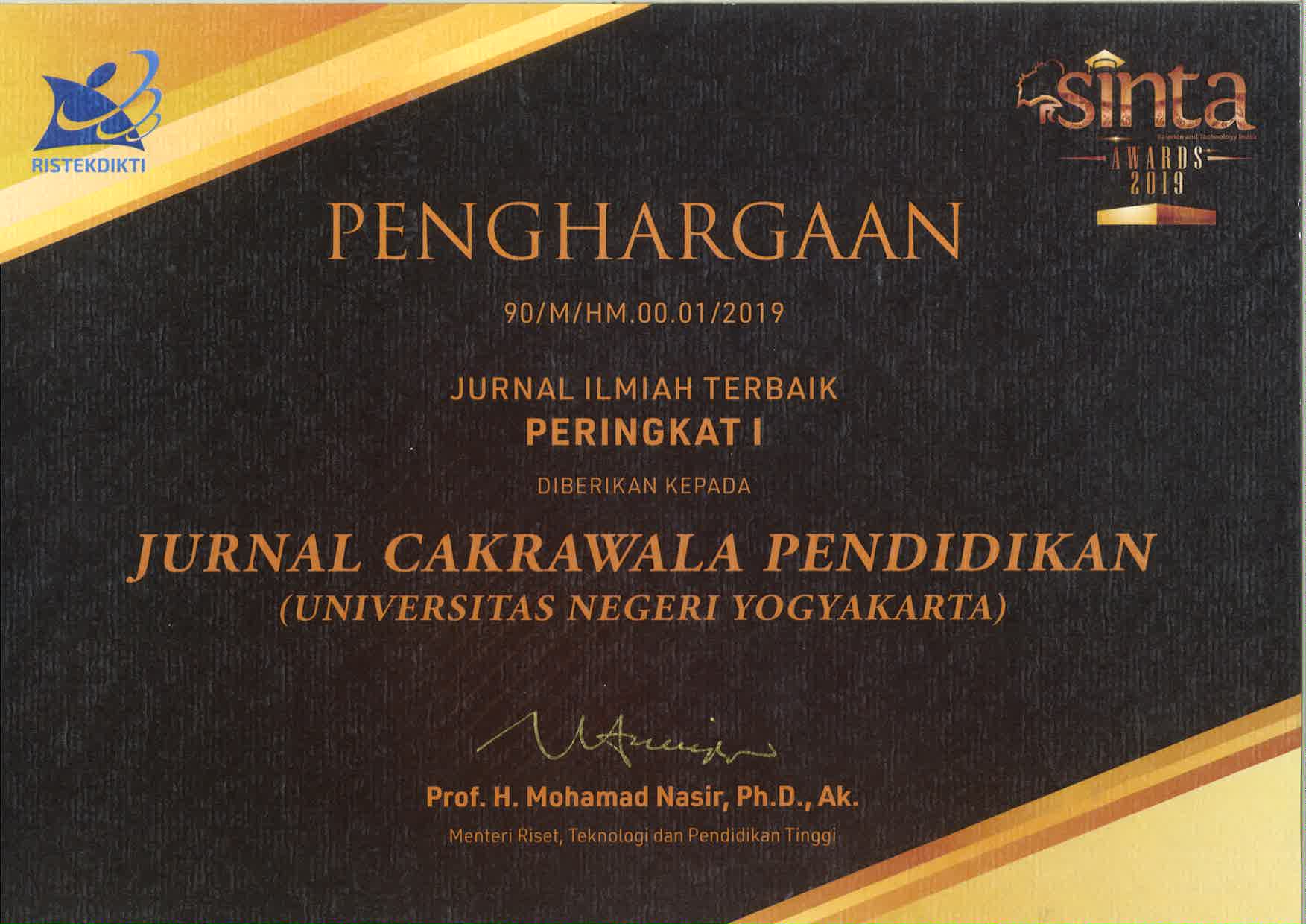Character Based Reflective Picture Storybook: Improving Student's Social Self-Concept in Elementary School
Downloads
MEDIA REFLECTIVE PICTURE STORYBOOK BERBASIS NILAI-NILAI KARAKTER: UNTUK MENINGKATKAN KONSEP DIRI SOSIALSISWA SD
Abstrak: Penelitian bertujuan: 1) menghasilkan media reflective picture storybookberbasis nilai-nilai karakter yang layak untuk meningkatkan konsep diri sosial siswa, dan 2) mengetahui keefektifan media dalam meningkatkan konsep diri sosial siswa. Metode penelitian menggunakan R&D yang mengacu pada 10 langkah pengembangan Borg & Gall.Subjek uji coba adalah siswa kelas V SD se-Kabupaten Bantul.Teknik pengumpulan data menggunakan wawancara, self-report, skala, dan observasi. Teknik analisis data menggunakan analisis deskriptif, manova, dan uji t.Hasil penelitian menunjukkan: 1) media yang dikembangkan telah memenuhi kriteria kelayakan berdasarkan validasi ahli media dan ahli materi, serta respons guru dan siswa dengan kategori sangat baik; 2) media yang dikembangkan efektif untuk meningkatkan konsep diri sosial siswa. Konsep diri sosial meningkat secara signifikan berdasarkan uji t pada taraf signifikansi 0.05, yang hasilnya 0.000 < α = 0.05). Melalui media yang dikembangkan, siswa dapat menginternalisasi nilai-nilai karakter dengan menyenangkan dan menambah wawasan berinteraksi dengan orang lain.
Kata Kunci: mediareflective picture storybook berbasis nilai-nilai karakter, konsep diri sosial
Downloads
REFERENCES Bakhurst & Sypnowich. (1995). The social self. London: SAGE Publications Ltd. Berman, S. (1990). Educating for social responsibility. Service Learning, General, 43, 75-80. Borg, W.R. & Gall, M.D. (1983). Educational research. New York: Longman Inc. Colwell, C. (2013). Children's storybooks in the elementary music classroom: a description of their use by orff-schulwerk teachers. Journal Music Therapy & Special Music Education, 5(2). 174-187. Dervent, F. (2015). The effect of reflective thinking on the teaching practices of preservice physical education teachers. Issues in Educational Research, 25(3), 260-275. DeWall, C.N. & Bushman, B.J. (2011). Social acceptance and rejection: The sweet and the bitter. Current Directions in Psychological Science, 20(4), 256–260. Fadjrie Kurnia Bella Ibnu. (2015). Perancangan animasi cerita inspiratif sebagai media pembentukan konsep diri untuk anak usia 3-5 tahun. Tesis, tidak diterbitkan. UNIKASoegijapranata. Fernández-Zabala, A., Rodríguez-Fernández, A., & Goñi, A. (2016). The structure of the social self-cconcept (ssc) questionnaire. Anales de Psicología, 32(1), 199-205. Fitts, W.H. (1971). The self concept and self actualization. Los Angeles, California: Western Psychological Services. Gillespie, A. (2005). Becoming other from social interaction to self-reflection. London: Information Age Publishing, Inc. Harisson J. & Dymoke S. (2009). Reflective teaching and learning; a guide to professional issues for beginning secondary teachers. London: Sage. Huck, C.S., Hepler, S., & Hickman, J. (1987). Children's literature in the elementary school. New York: Holt, Rinehart, and Winston. Kemp, J.E. & Dayton, D.K. (1985). Planning and producing instructional media (Fifth ed.). New York: Harper & Row Publishers, Inc. Laryea, J., Saani, A., & Brew, A. (2014). Influence of students self-concept on their academic performance in the elmina township. European Journal of Research and Reflection in Educational Sciences. 2(4), 1-10. Lukens, R. J. (1999). A critical handbook of children's literature (Sixth ed.). New York: Addison-Wesley Educational Publishers, Inc. Mitchell, D. (2003). Children's literature, an invitation to the world. Boston: Ablongman. Mourao, S. (2016). Picturebooks in the primary efl classroom: authentic literature for an authentic response. CLELE Journal, 4(1), 25-43. Nurgiyantoro, B. (2013). Sastra anak: Pengantar pemahaman dunia anak. Yogyakarta: Gadjah Mada University Press. Richter, T. & Calio F. (2014). Stories can influence the self-concept. Social Influence, 9( 3), 172–188. Santrock, J.W. (2011). Educational psychology (Fifth ed.). New York: The McGraw-Hill Companies, Inc. Semrud-Clikeman, M. (2007). Social competence in children. New York, PA: Springer Science & Business Media. Shambaugh, N. N. & Magliaro, S. G. (2006). Instructional design; a systematic approach for reflective practice. Boston: Pearson Education, Ltd. Stump, K., et.al. (2009). Theories of social competence from the top-down to the bottom-up: A case for considering foundational human needs. Lawrence: University of Kansas. Sukardjo. (2006). Collection of learning evaluation materials. Yogyakarta: UNY. Tompkins, G.E. & Hoskisson, K. (1995). Language arts: Content and teaching strategies (3rd ed.). Englewood Cliffs, New Jersey: Prentice-Hall, Inc. Turan, F. & Ulutas, I. (2016). Using Storybooks as a Character Education Tools. Journal of Education and Practice, 7(15), 169-176. Zaky, E. A. (2016). Once upon a time, we were all little kids too ! Influence of cartoon on children"Ÿs behavior; is it just a world of fantasy or a nightmare? International Journal of Science and Research, 5(5), 1296-1298. Zuchdi, D., Prasetya, Z.K., & Masruri, M.S. (2010). The development of character education model integrated in learning subjects in elementary school. Cakrawala Pendidikan, 1(3), 1-12.
Jurnal Cakrawala Pendidikan, Jurnal Ilmiah Pendidikan, with ISSN: 0216-1370, is published by the Institute of Education Development and Quality Assurance (LPPMP UNY). Cakrawala Pendidikan has been recently has been re-accredited by Indonesian Ministry of Education and Culture decision Number 230/E/KPT/2022 which is valid for five years since enacted on 30 December 2022.




























